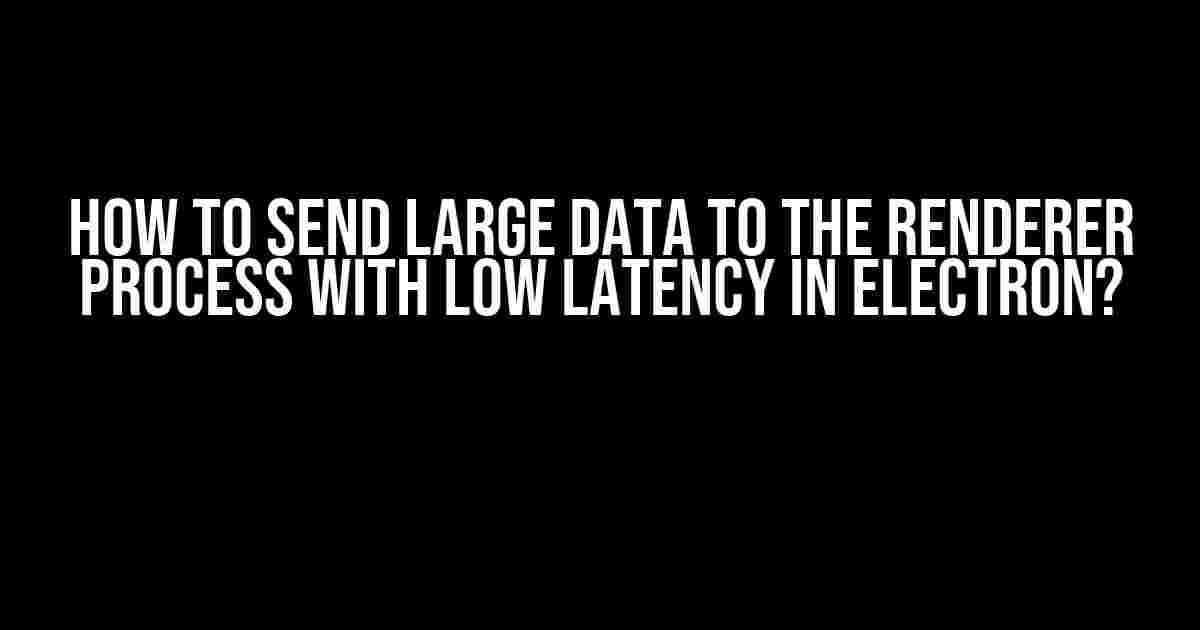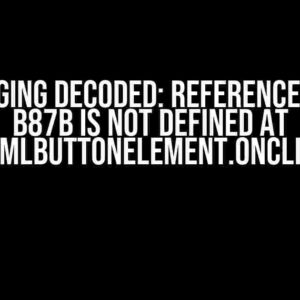Are you tired of dealing with slow and sluggish Electron applications? Do you struggle with sending large amounts of data from your main process to your renderer process without sacrificing performance? Well, worry no more! In this article, we’ll dive into the world of Electron and explore the best practices for sending large data with low latency.
Understanding the Problem
In Electron, the main process and renderer process are two separate entities that communicate with each other through IPC (Inter-Process Communication). When you need to send large amounts of data from the main process to the renderer process, things can get tricky. The default IPC mechanism in Electron uses JSON serialization, which can lead to performance issues when dealing with large datasets.
Imagine having to send a massive JSON object with hundreds of thousands of records from the main process to the renderer process. The JSON serialization process alone can take several seconds, causing your application to freeze and leaving your users frustrated.
Why Low Latency Matters
Low latency is crucial in modern applications, especially in real-time data visualization, live updates, or any scenario where data needs to be processed and rendered quickly. When data takes too long to transfer, it can lead to:
- Slow rendering times, causing the application to freeze or become unresponsive
- Poor user experience, leading to frustration and disappointment
- Inaccurate or outdated data, affecting the overall functionality of the application
Solutions for Sending Large Data with Low Latency
So, how do we overcome this challenge and send large data with low latency in Electron? Here are some solutions to get you started:
1. Using Electron’s `ipcRenderer` and `ipcMain` with Binary Serialization
One approach is to use Electron’s built-in `ipcRenderer` and `ipcMain` modules, along with binary serialization. This method allows you to send binary data instead of JSON, reducing the serialization overhead.
// main process
const ipcMain = require('electron').ipcMain;
const Buffer = require('buffer');
let largeData = [...]; // large dataset
ipcMain.on('request-data', (event) => {
const buffer = Buffer.from(JSON.stringify(largeData));
event.reply('data', buffer);
});
// renderer process
const ipcRenderer = require('electron').ipcRenderer;
ipcRenderer.on('data', (event, buffer) => {
const largeData = JSON.parse(buffer.toString());
// process largeData
});
2. Using `electron-ipc-bin` Library
The `electron-ipc-bin` library provides a more efficient way of sending binary data between the main process and renderer process. This library uses Node.js’s built-in `Buffer` class to send binary data, eliminating the need for JSON serialization.
// main process
const ipc = require('electron-ipc-bin');
let largeData = [...]; // large dataset
ipc.send('data', Buffer.from(largeData));
// renderer process
const ipc = require('electron-ipc-bin');
ipc.on('data', (buffer) => {
const largeData = Array.from(buffer);
// process largeData
});
3. Implementing Streaming with `electron-stream` Library
For extremely large datasets, streaming the data in chunks can be a more efficient approach. The `electron-stream` library allows you to create a stream from the main process to the renderer process, enabling you to process large data in real-time.
// main process
const stream = require('electron-stream');
let largeData = [...]; // large dataset
const stream = new stream.PassThrough();
largeData.forEach((chunk) => {
stream.write(chunk);
});
stream.end();
// renderer process
const stream = require('electron-stream');
const renderStream = new stream.PassThrough();
renderStream.on('data', (chunk) => {
// process chunk
});
stream.pipe(renderStream);
Best Practices for Optimal Performance
In addition to the solutions above, here are some best practices to keep in mind when dealing with large data in Electron:
- Use caching mechanisms: Implement caching for frequently accessed data to reduce the amount of data being sent between processes.
- Optimize data structure: Use efficient data structures, such as arrays or buffers, to minimize the size of the data being sent.
- Compress data: Compress data using algorithms like gzip or lz4 to reduce the size of the data being sent.
- Use parallel processing: Take advantage of multi-core processors by using parallel processing to speed up data processing and rendering.
- Monitor performance: Regularly monitor performance metrics, such as memory usage and rendering times, to identify bottlenecks and optimize accordingly.
Conclusion
Sending large data with low latency in Electron can be a challenging task, but with the right approaches and best practices, you can overcome this hurdle and build high-performance applications. By understanding the problem, exploring solutions, and implementing optimal practices, you can ensure your Electron application provides a seamless and responsive user experience.
| Solution | Advantages | Disadvantages |
|---|---|---|
| Using Electron’s `ipcRenderer` and `ipcMain` with Binary Serialization | Easy to implement, built-in support | Serialization overhead, limited to JSON data |
| Using `electron-ipc-bin` Library | Faster than JSON serialization, supports binary data | Additional library dependency, limited to binary data |
| Implementing Streaming with `electron-stream` Library | Real-time processing, efficient for large datasets | More complex implementation, requires additional setup |
Remember, the key to success lies in understanding the problem, choosing the right solution, and optimizing performance. By following the guidelines and best practices outlined in this article, you’ll be well on your way to building high-performance Electron applications that delight your users.
Frequently Asked Question
Electron developers, assemble! Are you struggling to send large data to the renderer process with low latency? Worry no more, we’ve got you covered!
What are the common bottlenecks when sending large data to the renderer process?
When sending large data to the renderer process, common bottlenecks include the serialization and deserialization of data, IPC (Inter-Process Communication) overhead, and rendering process limitations. These bottlenecks can cause significant latency, resulting in a poor user experience.
How can I reduce serialization and deserialization overhead when sending large data?
To reduce serialization and deserialization overhead, consider using binary data formats like MessagePack or BSON, which are more efficient than JSON. You can also use libraries like ` electron-serialize` to optimize the serialization process.
What are some strategies to minimize IPC overhead when sending large data?
To minimize IPC overhead, consider using `electron-main`’s ` ipcMain.handle` method, which allows you to handle large data in chunks. You can also use `electron-renderer`’s `ipcRenderer.invoke` method to send large data in multiple requests, reducing the overhead of a single large request.
How can I optimize the rendering process to handle large data efficiently?
To optimize the rendering process, consider using Web Workers to offload computationally intensive tasks, reducing the load on the main thread. You can also use lazy loading or pagination to render large data in smaller chunks, improving the overall responsiveness of your application.
Are there any Electron-specific APIs or libraries that can help with sending large data to the renderer process?
Yes, Electron provides the `electron-main`’s `ipcMain.handle` method, which allows you to handle large data in chunks. Additionally, libraries like `electron-serialize` and `electron.LargeData` can help optimize the serialization and deserialization process, reducing latency and improving performance.



